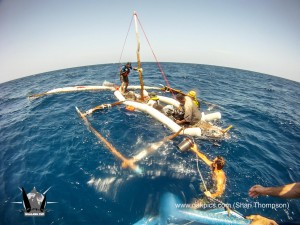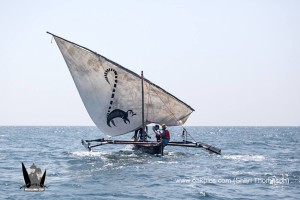25 February 2016
The Ngalawa Cup (Part Three)
A sailing adventure in the Indian Ocean.
by Alexander Nimmo
 Last week we left Alexander and crew returning to land with lashings coming loose and a detached outrigger; but the damage proves to be only a temporary setback…
Last week we left Alexander and crew returning to land with lashings coming loose and a detached outrigger; but the damage proves to be only a temporary setback…
We were delayed by a day, but had support in the form of two other teams who had also had to return, one with a broken boom and the other with a broken outrigger. Thankfully on day 5 of the race we were able to get going with no issues. We were now aiming to go as fast as we could towards the finish. This would make for long days, but we thought we could manage this for just four more days. The idea was to island hop along the archipelago, which is scattered with small desert islands.
The first island we stopped on provided one of the least pleasant nights of the entire experience. We were in a fishing village, which by way of fresh water had a well full of muddy grey gloop, and no fish they wanted to sell us. We built a campfire and slept in our hammocks on the beach after making and eating a thoroughly unappetising meal of beans and rice with a few random herbs thrown in. The beauty of the night sky with the Magellanic Clouds visible on the southern horizon was not lost on us, however.
The following morning there was a very light land breeze blowing, so we departed early, only to find that the breeze died to nothing about half a mile from the shore. We drifted and paddled our way onwards, concerned that we would not make our next island, some 25 miles away, before dark. Thankfully the breeze filled in around midday and we had an uneventful sail for the rest of the day, landing at our anticipated campsite at 18.38. There we met up with three other teams, so now there were four of us trailing the fleet. One of the rescue boats was also there and the skipper’s brother happened to be a fisherman on that island, so he called ahead and got a delicious meal of barbequed fish and octopus together for everyone to share. I had cut my feet up badly on the reef when we were ‘shipwrecked’, and since then my cuts had gradually filled with sand, making walking more than a few feet incredibly painful.
The island was a typical example of a tropical paradise, fine white sand, turquoise water and palm trees, with few inhabitants. However, it was blighted by the most persistent sand flies, which would not stop attacking us. We were fine as long as we kept covering ourselves in 50% DEET every 30 minutes or so, but it did detract from an otherwise idyllic setting.
The next day was the penultimate day of the race. All four teams set off towards our final night of camping, an island called Songa Songa. We may have been racing, but the beauty of the coral reefs tempted one team to stop and have a snorkel! The wind again built to around 25 knots over the day and our navigation into the island was tough, running the boat as close as we could to the wind between two reefs. We were thrilled to see a pod of five dolphins come towards us and play around the boat for a few minutes. It seems, though, we were not going fast enough for them and they soon got bored and moved on. However it really lifted our spirits to have seen these stunning creatures.
Songa Songa has tragically been spoilt by the discovery of gas, and the huge offshore drilling platform really detracted from another beautiful island. Once in, we met up with the other teams again and one of them went off to the local market to buy fish and fresh vegetables. The fish was a bream-like reef fish which we salted and rubbed with garlic before frying in a large pan over a fire. This was more like it!
With the past few days having gone so well, we were slightly sad that this would be our last night. At the same time we were excited at the prospect of finishing the following day, although we were only too well aware that anything could still happen! We had heard from the guys in the rescue boat that two teams had definitely finished and at least one team was camping on a tiny island just outside the entrance to the river mouth which marked the finishing line.
 Our final day again dawned clear and bright. We still had 26 miles to go, heading due south. We decided to cut off some time by going close inshore of a reef and hoping that the tide would be high enough to get over by the time we arrived. We saw two teams ahead of us try and work their way over it but without any luck, so we joined them in lowering the sail and walking the boat along this sandy bit of the reef.
Our final day again dawned clear and bright. We still had 26 miles to go, heading due south. We decided to cut off some time by going close inshore of a reef and hoping that the tide would be high enough to get over by the time we arrived. We saw two teams ahead of us try and work their way over it but without any luck, so we joined them in lowering the sail and walking the boat along this sandy bit of the reef.
The water here was picture-postcard clear with a sandy bottom and a wonderful turquoise hue. We crossed the reef and immediately turned right (west) towards our finishing line. We knew we couldn’t relax as the wind was very gusty and it was in similar conditions that we had had our first capsize. We lamented that it had taken us over nine days of sailing to master our boat, but finally it seemed, just as we were finishing, we were having the best sail of the whole trip!
Landing on the beach was a fantastic feeling. The organisers were there with cold beers; the other teams had all stuck around to cheer everyone in and we could not have been more proud of ourselves. We had had many moments when we wanted to quit, but overcoming this challenge had left us with a clear view that, whatever happened in our lives, if we could sail a dugout over 500 km in eight days we could do anything!
Please click here if you would like a weekly email on publication of the Shaw Sheet

